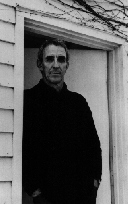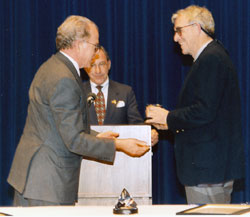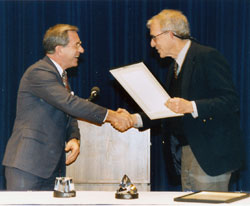AUTHOR PAGE

 PETER MATTHIESSEN
PETER MATTHIESSEN
State Author, 1995–1997
“I like to hear and smell the countryside, the land my characters inhabit.
I don’t want these characters to step off the page,
I want them to step out of the landscape.” — Peter Matthiessen
Peter Matthiessen, born in New York City on May 22, 1927, is a novelist, short story writer, and nonfiction writer who bases the majority of his writing on his personal travels. He writes about vanishing cultures, oppressed people, and exotic wildlife and landscapes, combining scientific observation with lyrical, intellectual prose that connects the world of art and the world of the natural sciences. “In fiction and in nonfiction, Peter Matthiessen is one of the shamans of literature,” says John L. Cobbs in Dictionary of Literary Biography. “He puts his audience in touch with worlds and forces which transcend common experience.”
 Matthiessen wrote his first novel, Race Rock (1954) while living in Paris. It established him as a serious, disciplined writer of perception and imagination with a penchant for description. While in Paris, he founded the Paris Review along with Harold L. Humes and was its first fiction editor.
Matthiessen wrote his first novel, Race Rock (1954) while living in Paris. It established him as a serious, disciplined writer of perception and imagination with a penchant for description. While in Paris, he founded the Paris Review along with Harold L. Humes and was its first fiction editor.
Upon returning to the United States in 1954, he settled in Long Island and worked for three years as a commercial fisherman and as captain of a charter fishing boat. It was during this time that he published his second novel, Partisans (1955).
In the late 1950s, Matthiessen began his series of travels that have informed and shaped his career and life. Between 1956–1963, expeditions to Alaska, Canadian Northwest Territories, Asia, Australia, Oceania and wilderness areas of South America, Africa, and New Guinea resulted in three books of nonfiction: Wildlife in America (1959), which is still in print and considered a classic of its form, The Cloud Forest: A Chronicle of the South American Wilderness (1961), and Under the Mountain Wall (1962). In addition, he published his third novel, Raditzer (1961).
 With the publication of his fourth novel, At Play in the Fields of the Lord (1965), which was nominated for a National Book Award, Matthiessen received considerable critical recognition. William Styron referred to At Play in the Fields of the Lord as “fiction of genuine stature, with a staying power that makes it as remarkable to read now as when it first appeared.” In 1991 the book was adapted into a film directed by Hector Babenco.
With the publication of his fourth novel, At Play in the Fields of the Lord (1965), which was nominated for a National Book Award, Matthiessen received considerable critical recognition. William Styron referred to At Play in the Fields of the Lord as “fiction of genuine stature, with a staying power that makes it as remarkable to read now as when it first appeared.” In 1991 the book was adapted into a film directed by Hector Babenco.
A year after his election to the National Institute of Arts and Letters (now the American Academy of Arts and Letters) in 1974, Matthiessen published his fifth novel, Far Tortuga. Widely considered to be his most inventive work of fiction, it is experimental in form, consisting mainly of dialogue with varied typographic formats. It relates the doomed voyage of a group of sailors who leave the Cayman Islands to hunt turtles in the Caribbean.
Matthiessen returned to nonfiction with the publication of The Snow Leopard (1978), winner of a National Book Award. Written out of his increasing interest in Zen, The Snow Leopard recounts his trip to the remotest parts of Nepal with the naturalist George Schaller in search of the Himalayan blue sheep and the rarely seen snow leopard. In bittersweet remembrance following the death of his wife, Matthiessen confronts the beauty, mysteries and often violent world of the Himalayas and his own equally strange and difficult feelings of life and death. W. Ross Winterowd called The Snow Leopard “a magnificent achievement, having all the power of a great novel . . . ”
During the 1980s Matthiessen wrote both fiction and nonfiction works. In Sand Rivers (1981), which received the John Burroughs Medal and the African Wildlife Leadership Foundation Award, Matthiessen describes an extended trek into the Selous Game Reserve, one of Africa’s largest remaining wilderness areas. With In the Spirit of Crazy Horse (1983) and Indian Country (1984), he turned his attention to the history, culture, and political plight of American Indians. Nine-Headed Dragon River, Zen Journals 1969–1982 (1986) tracks his practice of Zen Buddhism to his ordination as a Zen priest. Men’s Lives: The Surfmen and Baymen of the South Fork (1986) is an elegy for the deteriorating conditions of the fishing industry in eastern Long Island. In 1989, his first collection of short stories, On the River Styx, was published. And in 1990, he published his sixth novel, Killing Mister Watson, which won the Ambassador Award, English-Speaking Union. Continuing the experimental technique used in Far Tortuga, Matthiessen uses ten different narrators to tell this fictionalized account of a mysterious execution of a man in a tiny coastal village in the Everglades in 1910.
Matthiessen’s most recent works include Baikal: Sacred Sea of Siberia (1992) where he recounts his visit to Siberia and Lake Baikal, the oldest and deepest lake on the planet, Shadows of Africa (1992), which includes his essays on Africa from South Sudan to Zaire combined with drawings by artist Mary Frank, and East of Lo Monthang: In the Land of Mustang (1995).
“Peter Matthiessen has created a unique body of work. It is the work of a man in ecstatic contemplation of our beautiful and inexplicable planet . . . we behold a writer of phenomenal scope and versatility.” — William Styron in This Quiet Dust and Other Writings
Books by Peter Matthiessen:









SELECTED BIBLIOGRAPHY
FICTION
RACE ROCK. New York: Harper & Brothers, 1954.
PARTISANS. New York: Viking, 1955.
RADITZER. New York: Viking, 1961.
AT PLAY IN THE FIELDS OF THE LORD. New York: Random House, 1965.
FAR TORTUGA. New York: Random House, 1975.
ON THE RIVER STYX AND OTHER STORIES. New York: Random House, 1989.
KILLING MISTER WATSON. New York: Random House, 1990.
NONFICTION
WILDLIFE IN AMERICA. New York: Viking, 1959 and New York: Penguin Books, 1995. Revised, updated edition.
THE CLOUD FOREST: A CHRONICLE OF THE SOUTH AMERICAN WILDERNESS. New York: Viking Press, 1961.
UNDER THE MOUNTAIN WALL: A CHRONICLE OF TWO SEASONS IN THE STONE AGE. New York: Viking, 1962.
SAL SI PUEDES: CESAR CHAVEZ AND THE NEW AMERICAN REVOLUTION. New York: Random House, 1969.
THE TREE WHERE MAN WAS BORN. New York: E. P. Dutton, 1972.
THE SNOW LEOPARD. New York: Viking, 1978.
SAND RIVERS. New York: Viking, 1981.
IN THE SPIRIT OF CRAZY HORSE. New York: Viking, 1983.
INDIAN COUNTRY. New York: Viking, 1984.
NINE-HEADED DRAGON RIVER: ZEN JOURNALS 1969–1982. Boston: Shambhala Publications, 1986.
MEN’S LIVES: THE SURFMEN AND BAYMEN OF THE SOUTH FORK. New York: Random House, 1986.
AFRICAN SILENCES. New York: Random House, 1991.
BAIKAL: SACRED SEA OF SIBERIA. San Francisco: Sierra Club Books, 1992.
EAST OF LO MONTHANG: IN THE LAND OF MUSTANG. Boston: Shambhala Publications, 1995.
SELECTED RESOURCES
Criticism
Bender, Bert. “FAR TORTUGA and American Sea Fiction Since MOBY-DICK.” AMERICAN LITERATURE, vol. 56, May 1984, p. 227–48.
Dowie, William. PETER MATTHIESSEN. Boston: Twayne Publishers, 1991.
Patteson, Richard F. “AT PLAY IN THE FIELDS OF THE LORD: The Imperialist Idea and the Discovery of the Self.” CRITIQUE 21, no. 2, 1979, p. 5–14.
Styron, William. “Peter Matthiessen.” THIS QUIET DUST AND OTHER WRITINGS. New York: Random House, 1982, p. 249–52.
Winterowd, W. Ross. “Peter Matthiessen’s Lyric Trek.” IN THE RHETORIC OF THE “OTHER” LITERATURE. Carbondale, Ill.: Southern Illinois University Press, 1990, p. 133–39.
Profiles/Interviews
Bonetti, Kay. “An Interview with Peter Matthiessen.” THE MISSOURI REVIEW, vol. 12, no. 2, 1989, p. 109–24.
Cobbs, John L. “Peter Matthiessen.” American Novelists Since World War II: Second Series. Vol. 6, DICTIONARY OF LITERARY BIOGRAPHY, edited by James E. Kibler, Jr. Detroit: Gale Research Co., 1980, p. 218–23.
Plimpton, George. “The Craft of Fiction in FAR TORTUGA.” PARIS REVIEW, vol. 15, Winter 1974, p. 79–82.
Rea, Paul. “Causes and Creativity: An Interview with Peter Matthiessen.” RE ARTS & LETTERS: A LIBERAL ARTS FORUM, vol. 15, Fall 1989, p. 27–40.
Bibliography
Nicholas, D. PETER MATTHIESSEN: A BIBLIOGRAPHY: 1951–1979. Canoga Park, CA: Orirana Press, 1979.
For additional information, contact the Writers Institute at 518-442-5620 or online at https://www.albany.edu/writers-inst.